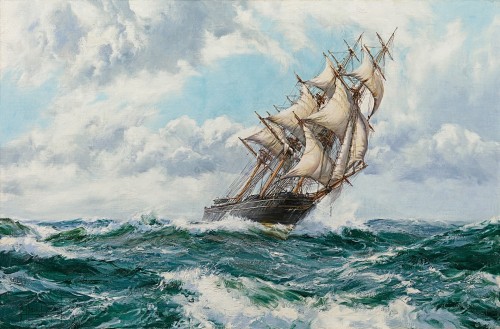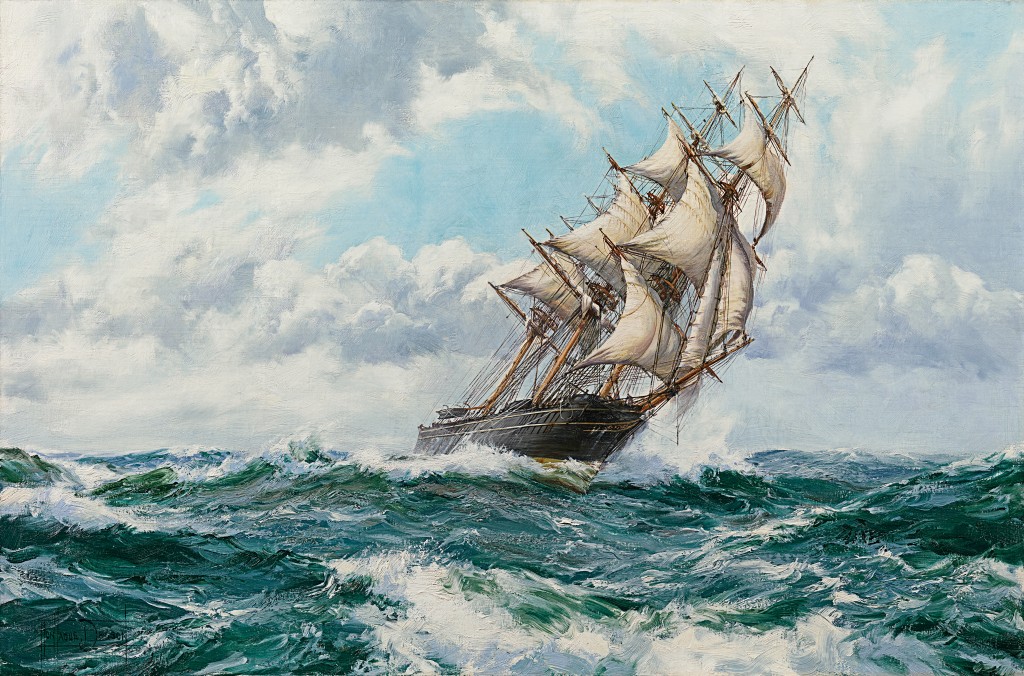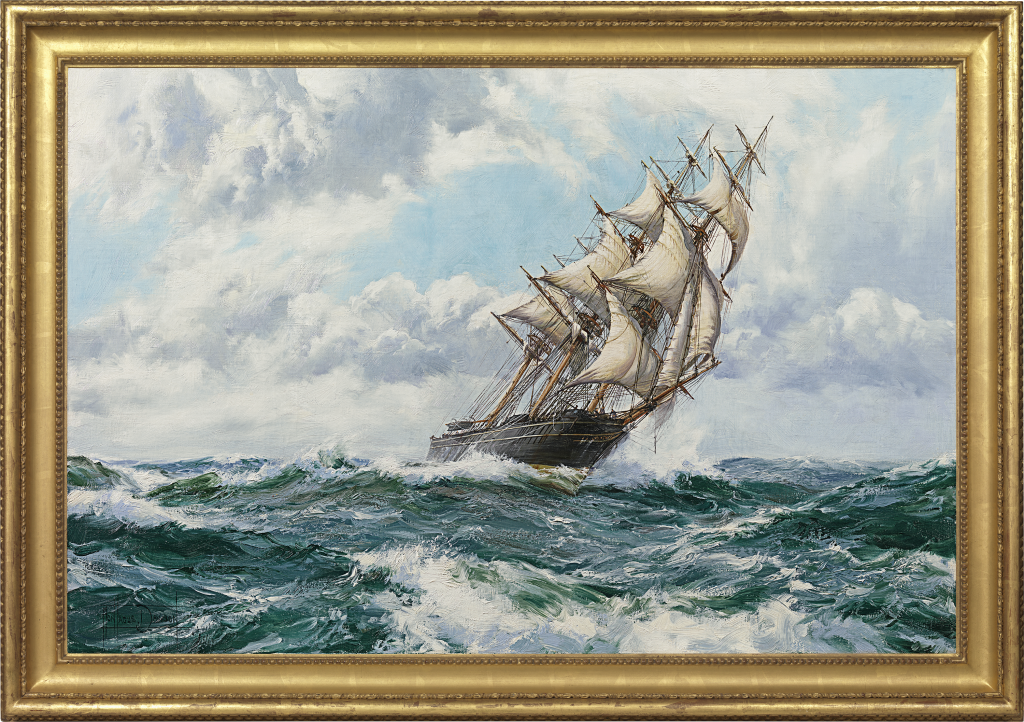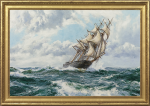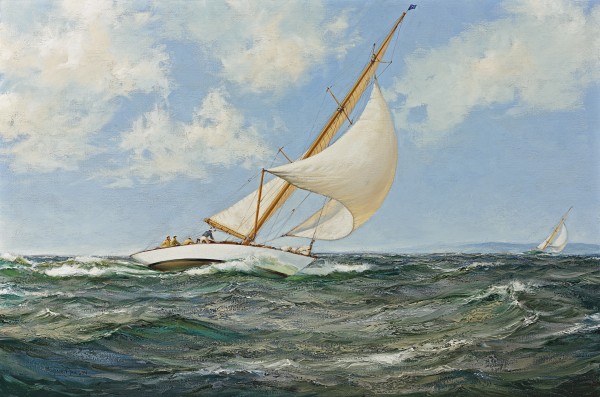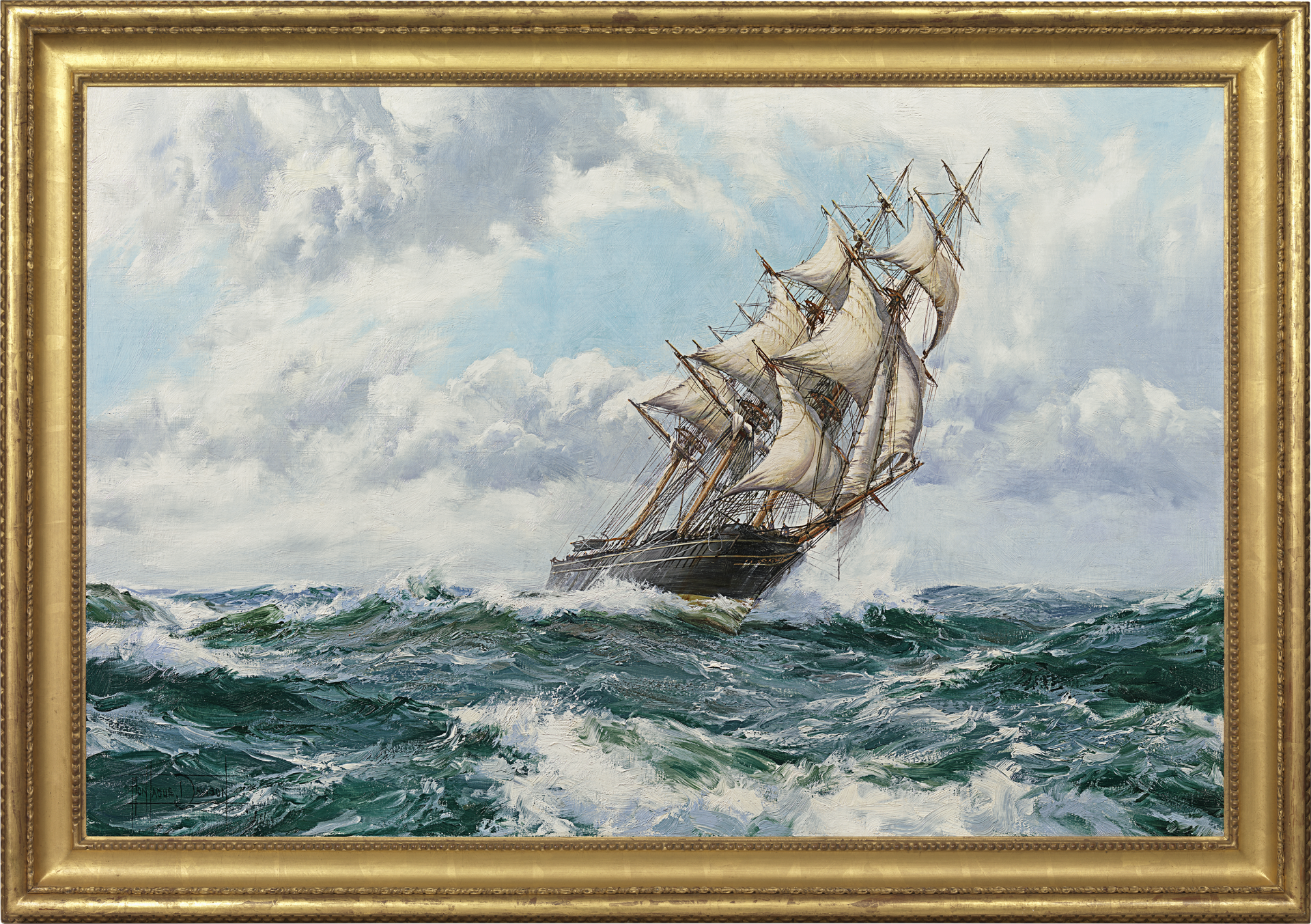MONTAGUE DAWSON
Chiswick 1895 - 1973 Midhurst, Sussex
Ref: CB 178
Billowing sails: the clipper Nightingale
Signed lower left: Montague Dawson; inscribed on the stretcher: Billowing Sails The Clipper Nightingale Built in 1851 of About 900 Tons
Oil on canvas: 24 x 36 in / 61 x 91.4 cm
Frame size: 30 ½ x 42 ½ in / 77.4 x 107.9 cm
Painted in the 1960s
Provenance:
Robert MacCrate (1922-2016), New York;
by descent
Among Montague Dawson’s finest works are his paintings of clipper ships, which dominated the seas from the 1840s to the 1890s and became potent icons of the age of sail. ‘Tall, elegant and twice as fast as any merchant ships before them, they were long and lean with sharp bows, raked masts and a great cumulus of sail’[1]. Clippers were developed by a brilliant handful of East Coast American ship designers in the 1840s, particularly for the New York to China tea trade, where speed was of the essence. In the right conditions, they could make over twenty knots per hour. With the California Gold Rush from 1848, larger (‘extreme’) clippers were built to round Cape Horn, carrying prospectors and goods from the eastern USA to the gold fields. British ship designers entered the race to build the finest ships from the 1850s.
The American extreme clipper Nightingale had an unusually long and varied history, which encompasses many of the famous – and infamous – events of the nineteenth century. Designed by Samuel Hanscomb, Jr., she was named after the Swedish operatic soprano Jenny Lind, nicknamed the ‘Swedish Nightingale’, who took America by storm in a tour that began in September 1850. The clipper Nightingale was 1066 tons, length 178 ft, beam 36 ft, depth 20 ft. She was launched at the Hanscomb Shipyard in Portsmouth, New Hampshire in 1851. Nightingale ‘was originally built to carry passengers to the World’s Fair [Great Exhibition] in London, and then to be exhibited in the Thames, as a typical American clipper ship. She was, therefore, fitted out regardless of expense with large saloons and the most luxurious cabin arrangements’[2].
Nightingale’s promoters ran out of money and she was instead sold in Boston for Sampson & Tappan’s Pioneer Line of Australian packets. It was the height of the Australian Gold Rush and in 1851-2 Nightingale made the voyage from Boston to Sydney in ninety days. For several years she was employed in the China tea trade, racing from Shanghai to London in ninety-one days in 1855[3].
In 1861 Nightingale was sold to Captain Francis Bowen, known as the ‘Prince of Slaves’, sent to Rio de Janeiro and sold on to one of Bowen’s cronies for a voyage to Africa under a Brazilian flag. On 21st April she was captured by the sloop of war USS Saratoga off Cabinda, Angola. The surviving slaves on board were taken to Liberia, a country in West Africa founded as a refuge for freed slaves. The Nightingale was sold to the US government and fitted out as a coal and store ship. During the American Civil War she served mostly in the Gulf of Mexico and was attacked by Confederate forces in the Mississippi on 12th October 1861, running aground but escaping further damage.
Nightingale was decommissioned on 20th June 1864. The following year she was sold to the Western Union Telegraph Co. and used to lay telegraph cable across the Bering Strait between Alaska and Russia. She made several voyages between San Francisco and Petropavlovsk. After returning to the merchant trade 1868-78, Nightingale was sold to SP Olsen of Kragerø in Norway, rerigged as a barque and employed in the timber trade between America and Europe.
On 17th April 1893, on a voyage from Liverpool to Halifax, Nova Scotia, Nightingale was abandoned at sea and her crew rescued by nearby vessels. Her beautiful figurehead depicting Jenny Lind appears to have been taken off the ship when it was refitted at Kragerø and was eventually rediscovered in 1994 in a barn in Sweden.
Note on the provenance
This painting was formerly in the collection of the distinguished lawyer Robert MacCrate (1922-2016). He served in the Pacific with the US Navy in World War II before graduating from Harvard Law School in 1948. He was Counsel to New York Governor Nelson D Rockefeller and Special Counsel to the Department of the Army for its investigation of the My Lai Massacre during the Vietnam War. Mr MacCrate was President of the American Bar Association in the 1980s.
MONTAGUE DAWSON
Chiswick 1895 - 1973 Midhurst, Sussex
Montague Dawson was the son of a keen yachtsman and the grandson of the marine painter Henry Dawson (1811-1878). Much of his childhood was spent on Southampton Water where he was able to indulge his interest in the study of ships. For a brief period around 1910 Dawson worked for a commercial art studio in London, but with the outbreak of the First World War he joined the Royal Navy. Whilst serving with the Navy in Falmouth he met Charles Napier Hemy (1841-1917), who considerably influenced his work. Dawson was present at the final surrender of the German Grand Fleet and many of his illustrations depicting the event were published in the Sphere.
After the War, Dawson established himself as a professional marine artist, concentrating on historical subjects and portraits of deep-water sailing ships often in stiff breeze or on high seas. During the Second World War, he was employed as a war artist and again worked for the Sphere. Dawson exhibited regularly at the Royal Society of Marine Artists, of which he became a member, from 1946 to 1964, and occasionally at the Royal Academy between 1917 and 1936. By the 1930s he was considered one of the greatest living marine artists, whose patrons included two American Presidents, Dwight D Eisenhower and Lyndon B Johnson, as well as the British Royal Family.
The work of Montague Dawson is represented in the National Maritime Museum, Greenwich and the Royal Naval Museum, Portsmouth.
[1] Ron Ranson, The Maritime Paintings of Montague Dawson, Newton Abbot 1993, p.24.
[2] Basil Lubbock, The China Clippers, Glasgow 1919, repr. 1981, p.67.
[3] Lubbock, op. cit., p.84.

